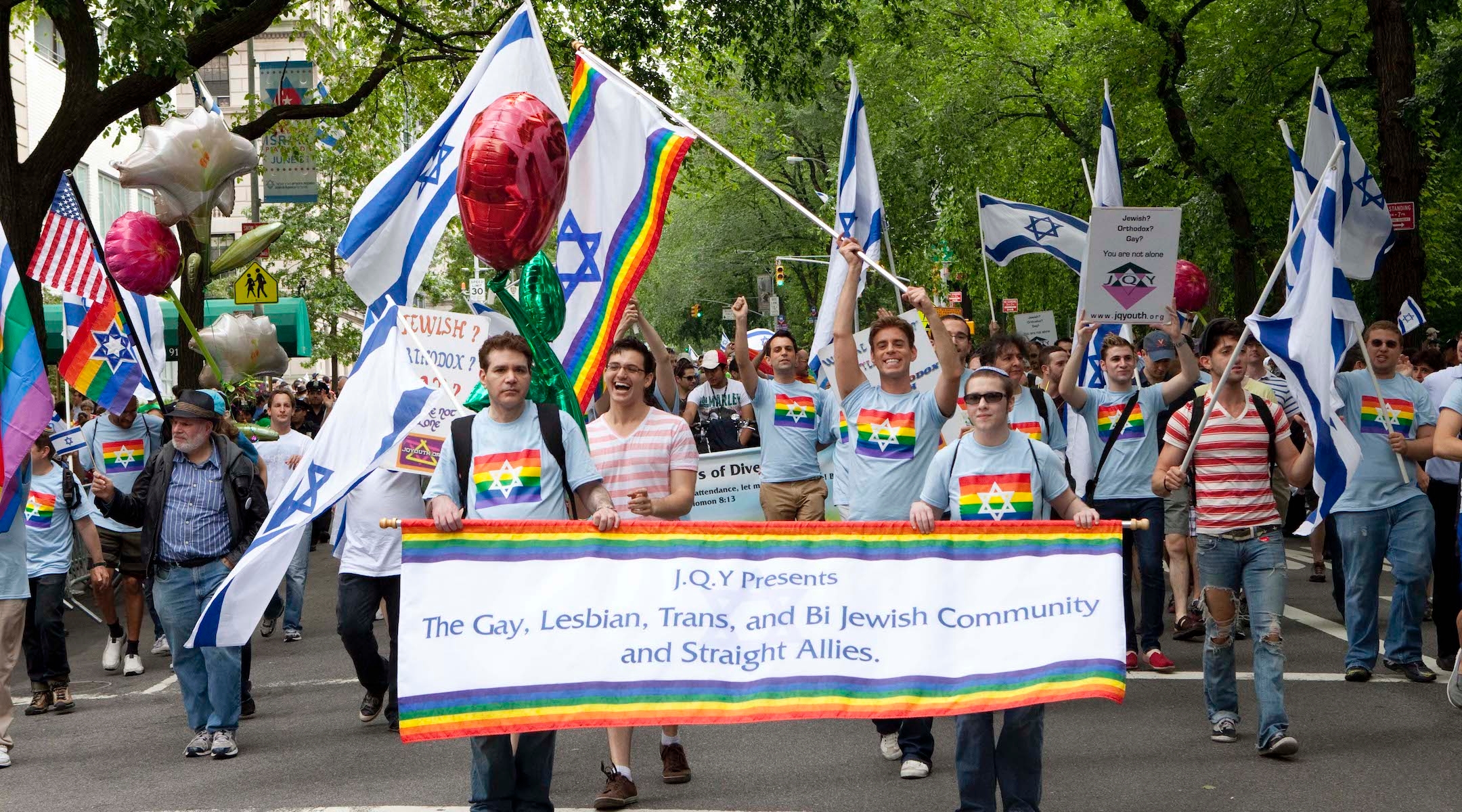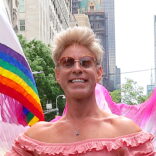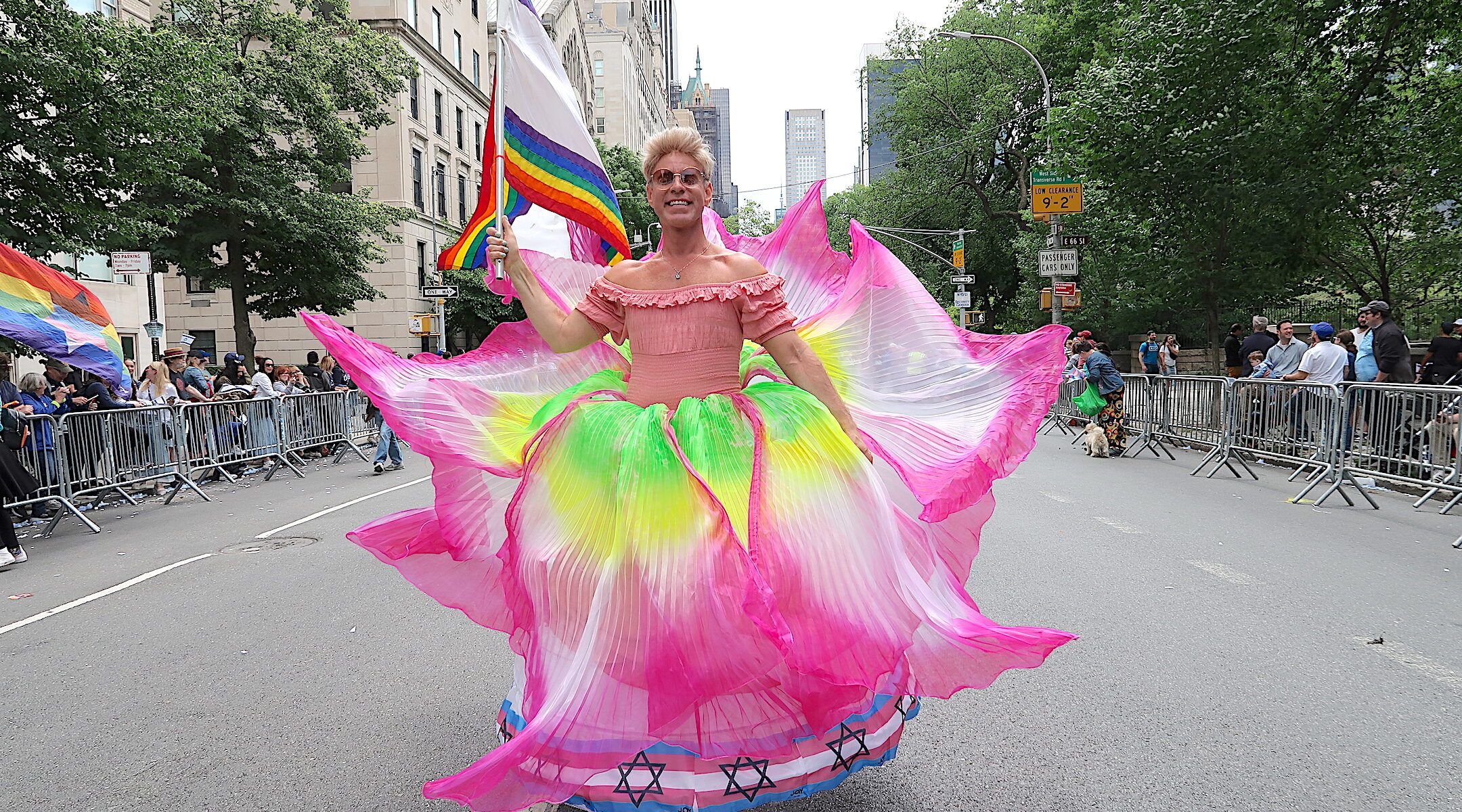(JTA) — “Look mom, he’s a beautiful butterfly,” a child shouted, pointing at me, as I marched up Fifth Avenue in drag on June 4 at the Celebrate Israel Parade.
I could only imagine how meaningful it would have been for me as a kid to see drag included as part of this annual Jewish communal celebration on Fifth Avenue. I didn’t know that boys were allowed to be beautiful. Worse, I thought that there was something shameful about my own longing to embrace my femininity. Certainly, growing up, there were many who seemed only too happy to reinforce that shame. Now, strutting proudly in the parade in a fabulous pink sundress and 9-inch heels is my way of creating a Jewish world where one’s whole self belongs.
Drag helps me find joy in not fitting neatly into boxes or binaries. As a queer Jew who grew up in an Orthodox family, non-binary identity is not just a helpful framing for my gender, it also best captures my approach to religion and my relationship with Israel. Not quite a man and not quite Orthodox, I am equally not quite a woman and kind of Orthodox. While I may not label myself a Zionist, I most certainly celebrate Israel and consider the nation central to my Judaism.
For me, these internal conflicts create the tension that energizes my art. The ability to hold seemingly opposing identities at once provides an authenticity that is both thrilling and freeing. Perhaps this is why I am so drawn to drag. What better art form to express the full spectrum of identity with all its contradictions, complications, and kaleidoscopic colors? I find drag the most exciting and self-actualizing way to fully show up in a parade that celebrates the complexity of Jewish heritage and homeland.
My drag also pays homage to the unapologetic fighting spirit that allowed queer Jews into the parade in the first place. Today, the Jewish Community Relations Council-NY (the parade’s producers) fully embraces the LGBTQ marching cluster and makes us feel like valued members of the Jewish community. But queer organizations were not always welcome at this event. When New York’s gay synagogue attempted to March in the early 1990s, its invitation was rescinded when Orthodox day schools (which still appear to make up the majority of marching schools) threatened to pull out from a parade with an LGTBQ contingent.
As a closeted teen in yeshiva, I remember feeling crushed when I read about the parade’s gay ban. The internalized message was clear: I’m not wanted and there is no place for me in this Jewish community. I recall feeling angry that it seemed like queer Jewish organizations just gave up and gave in to homophobia without a fight. This fury became a drive that helped create JQY (Jewish Queer Youth), the organization I co-founded whose mission is to support LGBTQ youth from Orthodox homes.
It was not until years later, in 2012, when a 16-year-old JQY member named Jon asked if we could march in the Celebrate Israel parade, that I knew it was time to reopen the fight for queer inclusion. That year JQY organized a cluster of queer Jewish organizations and applied to march as an official LGBTQ contingent. At first there was little resistance and our application was accepted. But two weeks before the parade, I was contacted by the parade’s director, informing me that the banner for our marching group must have “no reference to a LGBT or Gay and Lesbian community.” Apparently, once again Orthodox schools were threatening to boycott the parade if queers were to be allowed to march under an LGBT banner.
This time, however, JQY would not back down. I made it clear to the parade director that his request to erase our community identity is unacceptable and that we intended to show up on parade Sunday ready to march with a banner that read “Gay, Lesbian, Bi, Trans Jewish Community.” I told the director that he was welcome to call the police and deal with the optics of arresting queer Jews attempting to celebrate Israel.
Soon after, I began getting phone calls from leaders of the largest queer Jewish organizations. To my surprise, instead of being encouraging, they pressured me to stand down and compromise. Their concern was that my position made queer Jews seem “divisive.” I nearly gave in to these calls for appeasement until I spoke with Larry Kramer, the gay activist, playwright and personal hero of mine. Larry’s words still ring true today. “They were wrong then and they are wrong now,” he said. “The pressure to not be divisive is just a convenient and cowardly device for professionals to hang their internalized homophobia [on].”
The JQY team devised a plan. Prior to the parade’s pushback, we had already received an invitation to a pre-parade wine-and-cheese reception hosted by Fox TV, which was televising the parade that year. I would attend the event with Jon, the JQY member who inspired this parade advocacy, and we would speak to every journalist in the room, letting them know how excited and thankful we were that, for the first time ever, there would be an LGBTQ marching cluster.
When we approached the parade director who was flanked by Fox TV execs, we shook his hand and loudly congratulated him on the incredible milestone for queer inclusion. Cornered and in the spotlight, his response could not have been more perfect. “Yes, we are so proud to have an LGBTQ cluster this year,” he said. We had won.
(Noam Gilboord, the chief operating officer of JCRC-NY, confirmed this account. He said he had not been aware of the pushback against JQY at the time and noted that a highlight of his parade experience this year was handing an Israeli flag to a friend’s trans daughter, who was marching with her community.)
That Sunday our LGBTQ Community cluster had more than 100 marching participants made up of queer Jews of all ages and denominations, as well as friends, family, and allies. We received an overwhelmingly supportive reaction from the crowd, made up of mostly Orthodox Jews. We felt like we were healing old wounds and breaking new ground. Most importantly, we demonstrated that Jewish unity means including the LGBTQ Jewish community by name.
The organizers of the parade were so impressed with our contingent that they awarded us the Most Enthusiastic Participation Award. With subsequent yearly participation, our LGBTQ cluster has become a parade staple and highlight for onlookers. It is one of JQY’s proudest accomplishments.

JQY leads the first-ever LGBTQ contingent in the Celebrate Israel parade in 2012. (Robert Saferstein)
I believe that it is precisely JQY’s focus on uplifting complex identities that made our case to join the parade so strong. For most of our teens, celebrating Israel is part of what it means to both be Jewish and part of the Jewish community (the nation of Israel). Participation in the parade for them is about belonging, not support for any political structure or agenda. It makes sense that Jewish queer youth want to experience communal belonging in an LGBTQ-affirming way. Yet there are still those on the extreme political right and left who refuse to see this nuance and put our participants at risk.
In 2017 our LGBTQ contingent was targeted, infiltrated and sabotaged by members of Jewish Voice for Peace, an anti-Israel activist group. The protesters physically pushed, surrounded and blocked terrified queer Jewish minors who were bravely marching in front of their Orthodox families. Little did our teens know that it was bigotry from the left that would come for them that day.
This year we were particularly wary of marching among a predominantly Orthodox crowd — not because the Orthodox community has gotten more religious or pious, but because of reports that the Orthodox community has become more influenced by a political right that increasingly targets the LGBTQ community. One of the most influential public figures on the right is Ben Shapiro, an Orthodox Jew who, besides being fixated on canceling companies that work with trans people, recently published an article blaming LGBTQ acceptance for the “failure of modern Orthodox Judaism.”
Our contingent this year was mostly met with smiles, cheers and applause. However, it was difficult to ignore the handful of people on nearly every block who covered their children’s faces, displayed angry thumbs down signs and even shouted homophobic or transphobic slurs as we passed. Over the last few years I have noticed an uptick in these kinds of negative responses. It would be negligent not to connect this change to the recent nation-wide scapegoating of trans youth, drag artists, and LGBTQ acceptance.
This week, for the first time ever, the Human Rights Campaign declared an LGBTQ state of emergency in the United States, after lawmakers in 45 states proposed anti-trans bills in 2023. Of those, 24 have proposed “Don’t Say Gay” laws that criminalize discussion of LGBTQ issues in public schools, and lawmakers in 14 states have proposed anti-drag laws. Politicians and pundits with huge platforms are openly describing queer advocates as “groomers,” conveying that there is a pedophilic sexual agenda to the call for LGBTQ human rights and dignity.
This is the environment that LGBTQ Jewish youth live in today and experienced while marching in front of the Jewish community at this year’s parade. This is why I chose to march in drag. Marching is an exercise in building resilience and self-esteem in the face of adversity. My message is to not be afraid, to never back down and to be as magnificent as possible. These principles are the foundations of drag.
Drag is a queer art form that empowers us to express ourselves with every color imaginable. Drag elicits joy and entertainment by subverting expectations and turning gender expression into theatrical performance. It is an artistic genre that can be innocent or scandalous. The form ranges from family-friendly fun like “Mrs. Doubtfire” and Drag Queen Story Hours, to hit TV shows like “RuPaul’s Drag Race” and the more adult fare found in late night bars.
At the Celebrate Israel parade, drag is as natural an aesthetic for queer marchers as Bukharan music and garb are to the Russian-speaking Jewish community cluster. For many LGBTQ Jews, drag is as much a part of our culture and heritage as the celebration of Israel. This year, I was the first participant to march in drag. Next year, I hope many more will follow. Because let’s face it, nothing lights up a parade quite like a fabulous drag queen.
JTA has documented Jewish history in real-time for over a century. Keep our journalism strong by joining us in supporting independent, award-winning reporting.







